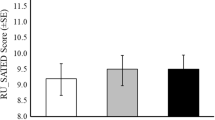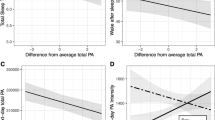Abstract
Background
Research has demonstrated a correlational relationship between sleep and physical activity, though this work has been largely cross sectional and fails to demonstrate temporal relationships. The purpose of this study was to test the daily, bidirectional relationships between sleep and physical activity, and whether this varied between weekdays and weekend days.
Method
Fifty-four healthy, young adults wore a Fitbit Flex to measure sleep and physical activity during a 6-day study period.
Results
Mixed linear models revealed that physical activity did not predict subsequent night’s sleep. However, on nights when participants had longer than their own average total sleep time, and greater than their own average wake after sleep onset, this predicted less physical activity the following day.
Conclusion
Results suggest that, in healthy young adults, physical activity may not promote healthier subsequent sleep, but sleep duration and continuity influence physical activity in their own way. Young adults may respond differently to health promotion efforts, and a greater understanding of these temporal associations can enhance the efficacy of these efforts.
Similar content being viewed by others
References
Blair SN, Brodney S. Effects of physical inactivity and obesity on morbidity and mortality: current evidence and research issues. Med Sci Sports Exerc. 1999;31:646–62.
Cappuccio FP, D’Elia L, Strazzullo P, Miller MA. Sleep duration and all-cause mortality: a systematic review and meta-analysis of prospective studies. Sleep. 2010;33:585–92.
Kline CE. The bidirectional relationship between exercise and sleep: implications for exercise adherence and sleep improvement. Am J Lifestyle Med. 2014;8:375–9.
Chennaoui M, Arnal PJ, Sauvet F, Léger D. Sleep and exercise: a reciprocal issue? Sleep Med Rev. 2015;20:59–72.
Lang C, Kalak N, Brand S, Holsboer-Trachsler E, Pühse U, Gerber M. The relationship between physical activity and sleep from mid adolescence to early adulthood. A systematic review of methodological approaches and meta-analysis. Sleep Med Rev. 2016;28:32–45.
Youngstedt SD, Kline CE. Epidemiology of exercise and sleep. Sleep Biol Rhythms. 2006;4:215–21.
Kline CE, Irish LA, Krafty RT, Sternfeld B, Kravitz HM, Buysse DJ, et al. Consistently high sports/exercise activity is associated with better sleep quality, continuity and depth in midlife women: the SWAN sleep study. Sleep. 2013;36:1279–88.
Irish LA, Kline CE, Gunn HE, Buysse DJ, Hall MH. The role of sleep hygiene in promoting public health: a review of empirical evidence. Sleep Med Rev. 2015;22:23–36.
Yang PY, Ho KH, Chen HC, Chien MY. Exercise training improves sleep quality in middle- aged and older adults with sleep problems: a systematic review. J Physiother. 2012;58:157–63.
Kredlow MA, Capozzoli MC, Hearon BA, Calkins AW, Otto MW. The effects of physical activity on sleep: a meta-analytic review. J Behav Med. 2015;38:427–49.
Irish LA, Kline CE, Rothenberger SD, et al. A 24-hour approach to the study of health behaviors: temporal relationships between waking health behaviors and sleep. Ann Behav Med. 2013;47:189–97.
Lambiase MJ, Gabriel KP, Kuller LH, Matthews KA. Temporal relationships between physical activity and sleep in older women. Med Sci Sports Exerc. 2013;45:1–14.
Dzierzewski JM, Buman MP, Giacobbi PR, et al. Exercise and sleep in community-dwelling older adults: evidence for a reciprocal relationship. J Sleep Res. 2014;23:61–8.
Tang NK, Sanborn AN. Better quality sleep promotes daytime physical activity in patients with chronic pain? A multilevel analysis of the within-person relationship. PLoS One. 2014;9:1–9.
Baron KG, Reid KJ, Zee PC. Exercise to improve sleep in insomnia: exploration of the bidirectional effects. J Clin Sleep Med. 2013;9:819–24.
Mitchell JA, Godbole S, Moran K, et al. No evidence of reciprocal associations between daily sleep and physical activity. Med Sci Sports Exerc. 2016;48:1950–6.
Wittmann M, Dinich J, Merrow M, Roenneberg T. Social jetlag: misalignment of biological and social time. Chronobiol Int. 2006;23:497–509.
Dickinson DL, Cazier J, Cech T. A practical validation study of a commercial accelerometer using good and poor sleepers. Health Psychol Open. 2016;3:1–10.
Mantua J, Gravel N, Spencer R. Reliability of sleep measures from four personal health monitoring devices compared to research-based actigraphy and polysomnography. Sensors. 2016;16(5):646.
Diaz KM, Krupka DJ, Chang MJ, Peacock J, Ma Y, Goldsmith J, et al. Fitbit®: an accurate and reliable device for wireless physical activity tracking. Int J Cardiol. 2015;185:138–40.
Sushames A, Edwards A, Thompson F, McDermott R, Gebel K. Validity and reliability of Fitbit Flex for step count, moderate to vigorous physical activity and activity energy expenditure. PLoS One. 2016;11(9):1–14.
Newsom J, Jones RN, Hofer SM. Longitudinal data analysis: a practical guide for researchers in aging, health, and social sciences. New York, NY: Routledge; 2013.
Youngstedt SD, O’connor PJ, Dishman RK. The effects of acute exercise on sleep: a quantitative synthesis. Sleep. 1997;20:203–14.
Johnson SS, Paiva AL, Cummins CO, Johnson JL, Dyment SJ, Wright JA, et al. Transtheoretical model-based multiple behavior intervention for weight management: effectiveness on a population basis. Prev Med. 2008;46(3):238–46.
Funding
This work was financially supported by NSF EPSCoR Infrastructure Improvement Track-1 Cooperative Agreement Award OIA-1355466.
Author information
Authors and Affiliations
Corresponding author
Ethics declarations
Ethical Approval
All procedures performed in studies involving human participants were in accordance with the ethical standards of the institution and with the 1964 Helsinki declaration and its later amendments or comparable ethical standards.
Conflict of Interest
The authors declare that they have no conflict of interest.
Additional information
Publisher’s Note
Springer Nature remains neutral with regard to jurisdictional claims in published maps and institutional affiliations.
Rights and permissions
About this article
Cite this article
Mead, M.P., Baron, K., Sorby, M. et al. Daily Associations Between Sleep and Physical Activity. Int.J. Behav. Med. 26, 562–568 (2019). https://doi.org/10.1007/s12529-019-09810-6
Published:
Issue Date:
DOI: https://doi.org/10.1007/s12529-019-09810-6




